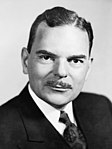| |||||||||||||||||||||||||||||||||||||
531 members of the Electoral College 266 electoral votes needed to win | |||||||||||||||||||||||||||||||||||||
|---|---|---|---|---|---|---|---|---|---|---|---|---|---|---|---|---|---|---|---|---|---|---|---|---|---|---|---|---|---|---|---|---|---|---|---|---|---|
| Turnout | 52.2%[1] | ||||||||||||||||||||||||||||||||||||
| |||||||||||||||||||||||||||||||||||||
 Presidential election results map. Blue denotes states won by Truman/Barkley, red denotes those won by Dewey/Warren, and orange denotes those won by Thurmond/Wright, including a Tennessee faithless elector. Numbers indicate the number of electoral votes allotted to each state. | |||||||||||||||||||||||||||||||||||||
| |||||||||||||||||||||||||||||||||||||
The 1948 United States presidential election was the 41st quadrennial presidential election. It was held on Tuesday, November 2, 1948. In one of the greatest election upsets in American history,[2][3][4] incumbent Democratic President Harry S. Truman defeated heavily favored Republican New York Governor Thomas E. Dewey, and third-party candidates, becoming the third president to succeed to the presidency upon his predecessor's death and be elected to a full term.[c]
Truman had been elected vice president in the 1944 election, and succeeded to the presidency in April 1945 upon the death of Franklin D. Roosevelt. He won his party's nomination at the 1948 Democratic National Convention only after defeating attempts to drop him from the ticket. The convention's civil rights plank caused a walkout by several Southern delegates, who launched a third-party "Dixiecrat" ticket led by South Carolina Governor Strom Thurmond. The Dixiecrats hoped to win enough electoral votes to force a contingent election in the House of Representatives, where they could extract concessions from either Dewey or Truman in exchange for their support. Former vice president Henry A. Wallace also challenged Truman by launching the Progressive Party and criticizing his confrontational Cold War policies. Dewey, the leader of his party's liberal eastern wing and the 1944 Republican presidential nominee, defeated conservative Ohio Senator Robert A. Taft and other challengers at the 1948 Republican National Convention. This was the first election to have primary and general election debates, with Dewey debating Harold Stassen in the Republican primary, while Norman Thomas debated Farrell Dobbs in the general election.[5]
Truman's feisty campaign style energized his base of traditional Democrats, consisting of most of the white South, as well as labor unions, and Catholic and Jewish voters; he also fared surprisingly well with Midwestern farmers.[6] Dewey ran a low-risk campaign and avoided directly criticizing Truman. With the three-way split in the Democratic Party, and with Truman's low approval ratings, Truman was widely considered to be the underdog in the race, and virtually every prediction (with or without public opinion polls) indicated Dewey would win the election. Defying these predictions, Truman won the election with 303 electoral votes to Dewey's 189. Truman also won 49.6% of the popular vote compared to Dewey's 45.1%, while the third-party candidacies of Thurmond and Wallace each won less than 3% of the popular vote, with Thurmond carrying four southern states in the Deep South. Truman's surprise victory was the fifth consecutive presidential win for the Democratic Party, the longest winning streak for the Democrats, and the longest for either party since the 1880 election.
With simultaneous success in the 1948 congressional elections, the Democrats regained control of both houses of Congress, which they had lost in 1946. Thus, Truman's election confirmed the Democratic Party's status as the nation's majority party. This was the last presidential election before the ratification of the 22nd Amendment in 1951, which would establish term limits for a president. This did not apply to the incumbent Truman, but as he chose not to run in 1952, this was the last presidential election with no future disqualification effect for second-term winners.[7] Additionally, this was one of only two elections held since the Democrats and Republicans became the two major parties in U.S. politics where a presidential candidate from either party lost despite carrying two of the three Rust Belt states of Michigan, Pennsylvania, and Wisconsin; the other election was 1968.[8]
- ^ "National General Election VEP Turnout Rates, 1789-Present". United States Election Project. CQ Press.
- ^ American Experience. "General Article: Presidential Politics". PBS. Archived from the original on February 21, 2017. Retrieved September 17, 2017.
- ^ Rosegrant, Susan (April 18, 2012). University of Michigan (ed.). "ISR and the Truman/Dewey upset". isr.umich.edu. Archived from the original on April 2, 2013.
- ^ Cosgrove, Ben (October 21, 2012). "Behind the Picture: 'DEWEY DEFEATS TRUMAN'". Time. Archived from the original on October 22, 2012.
- ^ "Should Minor Party & Independent Presidential Candidates "Debate Down"? Lessons of 1948". Ballot Access News. October 19, 2008. Archived from the original on March 23, 2021.
- ^ DiSalvo, Daniel (2010). "The Politics of a Party Faction: The Liberal-Labor Alliance in the Democratic Party, 1948–1972". Journal of Policy History. 22 (3): 269–299. doi:10.1017/S0898030610000114. S2CID 154735666.
- ^ Paul Kleppner et al. The Evolution of American Electoral Systems (1981) pp. 203–42
- ^ Brownstein, Ronald (September 16, 2024). "Why these three states are the most consistent tipping point in American politics". CNN. Retrieved September 16, 2024.
Cite error: There are <ref group=lower-alpha> tags or {{efn}} templates on this page, but the references will not show without a {{reflist|group=lower-alpha}} template or {{notelist}} template (see the help page).


